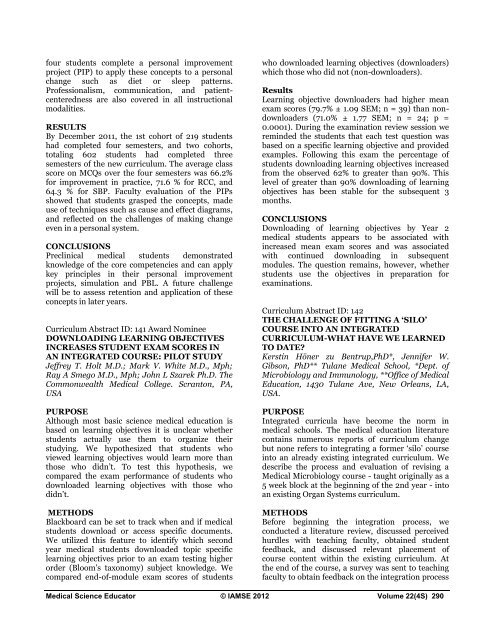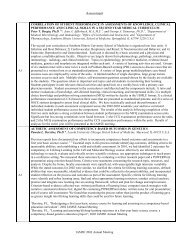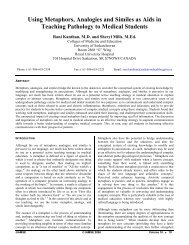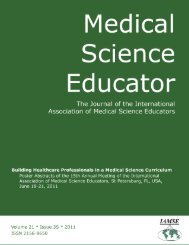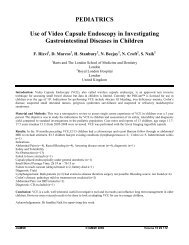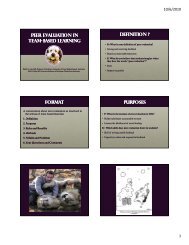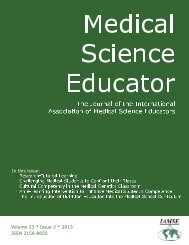Click here to view complete journal in pdf-format - IAMSE
Click here to view complete journal in pdf-format - IAMSE
Click here to view complete journal in pdf-format - IAMSE
You also want an ePaper? Increase the reach of your titles
YUMPU automatically turns print PDFs into web optimized ePapers that Google loves.
four students <strong>complete</strong> a personal improvement<br />
project (PIP) <strong>to</strong> apply these concepts <strong>to</strong> a personal<br />
change such as diet or sleep patterns.<br />
Professionalism, communication, and patientcenteredness<br />
are also covered <strong>in</strong> all <strong>in</strong>structional<br />
modalities.<br />
RESULTS<br />
By December 2011, the 1st cohort of 219 students<br />
had <strong>complete</strong>d four semesters, and two cohorts,<br />
<strong>to</strong>tal<strong>in</strong>g 602 students had <strong>complete</strong>d three<br />
semesters of the new curriculum. The average class<br />
score on MCQs over the four semesters was 66.2%<br />
for improvement <strong>in</strong> practice, 71.6 % for RCC, and<br />
64.3 % for SBP. Faculty evaluation of the PIPs<br />
showed that students grasped the concepts, made<br />
use of techniques such as cause and effect diagrams,<br />
and reflected on the challenges of mak<strong>in</strong>g change<br />
even <strong>in</strong> a personal system.<br />
CONCLUSIONS<br />
Precl<strong>in</strong>ical medical students demonstrated<br />
knowledge of the core competencies and can apply<br />
key pr<strong>in</strong>ciples <strong>in</strong> their personal improvement<br />
projects, simulation and PBL. A future challenge<br />
will be <strong>to</strong> assess retention and application of these<br />
concepts <strong>in</strong> later years.<br />
Curriculum Abstract ID: 141 Award Nom<strong>in</strong>ee<br />
DOWNLOADING LEARNING OBJECTIVES<br />
INCREASES STUDENT EXAM SCORES IN<br />
AN INTEGRATED COURSE: PILOT STUDY<br />
Jeffrey T. Holt M.D.; Mark V. White M.D., Mph;<br />
Ray A Smego M.D., Mph; John L Szarek Ph.D. The<br />
Commonwealth Medical College. Scran<strong>to</strong>n, PA,<br />
USA<br />
PURPOSE<br />
Although most basic science medical education is<br />
based on learn<strong>in</strong>g objectives it is unclear whether<br />
students actually use them <strong>to</strong> organize their<br />
study<strong>in</strong>g. We hypothesized that students who<br />
<strong>view</strong>ed learn<strong>in</strong>g objectives would learn more than<br />
those who didn’t. To test this hypothesis, we<br />
compared the exam performance of students who<br />
downloaded learn<strong>in</strong>g objectives with those who<br />
didn’t.<br />
METHODS<br />
Blackboard can be set <strong>to</strong> track when and if medical<br />
students download or access specific documents.<br />
We utilized this feature <strong>to</strong> identify which second<br />
year medical students downloaded <strong>to</strong>pic specific<br />
learn<strong>in</strong>g objectives prior <strong>to</strong> an exam test<strong>in</strong>g higher<br />
order (Bloom’s taxonomy) subject knowledge. We<br />
compared end-of-module exam scores of students<br />
who downloaded learn<strong>in</strong>g objectives (downloaders)<br />
which those who did not (non-downloaders).<br />
Results<br />
Learn<strong>in</strong>g objective downloaders had higher mean<br />
exam scores (79.7% ± 1.09 SEM; n = 39) than nondownloaders<br />
(71.0% ± 1.77 SEM; n = 24; p =<br />
0.0001). Dur<strong>in</strong>g the exam<strong>in</strong>ation re<strong>view</strong> session we<br />
rem<strong>in</strong>ded the students that each test question was<br />
based on a specific learn<strong>in</strong>g objective and provided<br />
examples. Follow<strong>in</strong>g this exam the percentage of<br />
students download<strong>in</strong>g learn<strong>in</strong>g objectives <strong>in</strong>creased<br />
from the observed 62% <strong>to</strong> greater than 90%. This<br />
level of greater than 90% download<strong>in</strong>g of learn<strong>in</strong>g<br />
objectives has been stable for the subsequent 3<br />
months.<br />
CONCLUSIONS<br />
Download<strong>in</strong>g of learn<strong>in</strong>g objectives by Year 2<br />
medical students appears <strong>to</strong> be associated with<br />
<strong>in</strong>creased mean exam scores and was associated<br />
with cont<strong>in</strong>ued download<strong>in</strong>g <strong>in</strong> subsequent<br />
modules. The question rema<strong>in</strong>s, however, whether<br />
students use the objectives <strong>in</strong> preparation for<br />
exam<strong>in</strong>ations.<br />
Curriculum Abstract ID: 142<br />
THE CHALLENGE OF FITTING A ‘SILO’<br />
COURSE INTO AN INTEGRATED<br />
CURRICULUM-WHAT HAVE WE LEARNED<br />
TO DATE?<br />
Kerst<strong>in</strong> Höner zu Bentrup,PhD*, Jennifer W.<br />
Gibson, PhD** Tulane Medical School, *Dept. of<br />
Microbiology and Immunology, **Office of Medical<br />
Education, 1430 Tulane Ave, New Orleans, LA,<br />
USA.<br />
PURPOSE<br />
Integrated curricula have become the norm <strong>in</strong><br />
medical schools. The medical education literature<br />
conta<strong>in</strong>s numerous reports of curriculum change<br />
but none refers <strong>to</strong> <strong>in</strong>tegrat<strong>in</strong>g a former ‘silo’ course<br />
<strong>in</strong><strong>to</strong> an already exist<strong>in</strong>g <strong>in</strong>tegrated curriculum. We<br />
describe the process and evaluation of revis<strong>in</strong>g a<br />
Medical Microbiology course - taught orig<strong>in</strong>ally as a<br />
5 week block at the beg<strong>in</strong>n<strong>in</strong>g of the 2nd year - <strong>in</strong><strong>to</strong><br />
an exist<strong>in</strong>g Organ Systems curriculum.<br />
METHODS<br />
Before beg<strong>in</strong>n<strong>in</strong>g the <strong>in</strong>tegration process, we<br />
conducted a literature re<strong>view</strong>, discussed perceived<br />
hurdles with teach<strong>in</strong>g faculty, obta<strong>in</strong>ed student<br />
feedback, and discussed relevant placement of<br />
course content with<strong>in</strong> the exist<strong>in</strong>g curriculum. At<br />
the end of the course, a survey was sent <strong>to</strong> teach<strong>in</strong>g<br />
faculty <strong>to</strong> obta<strong>in</strong> feedback on the <strong>in</strong>tegration process<br />
Medical Science Educa<strong>to</strong>r © <strong>IAMSE</strong> 2012 Volume 22(4S) 290


